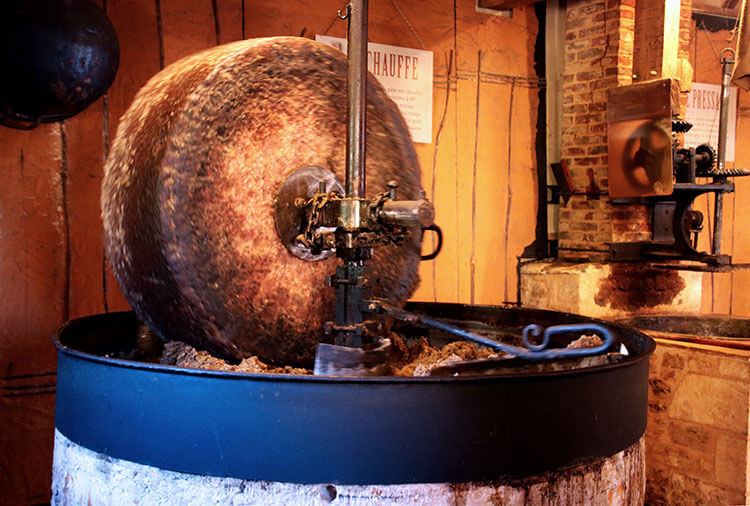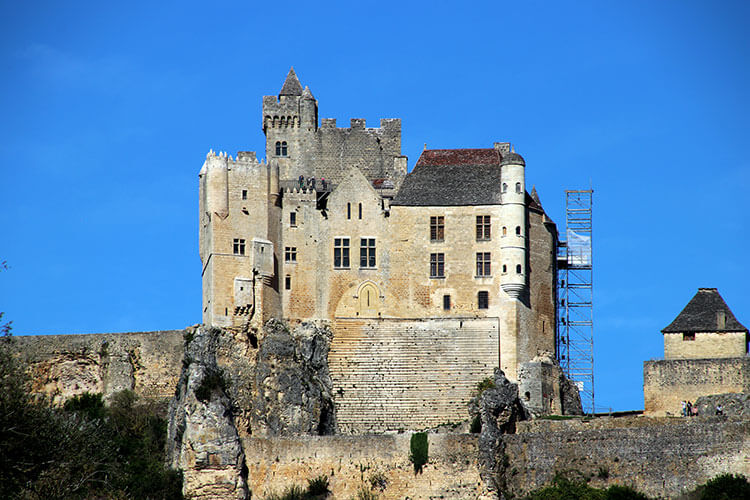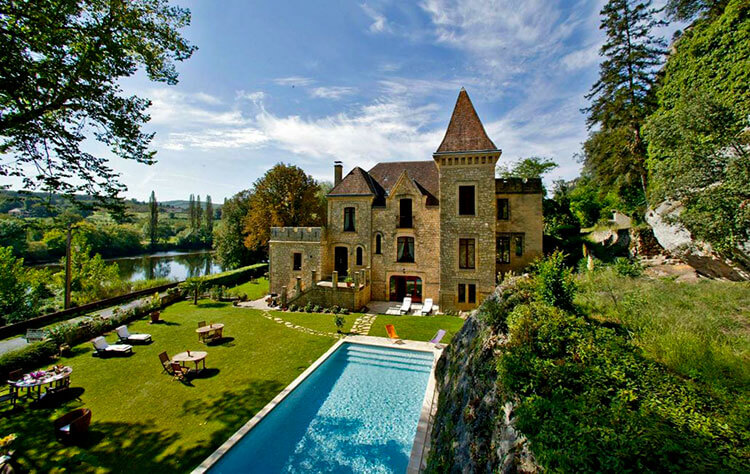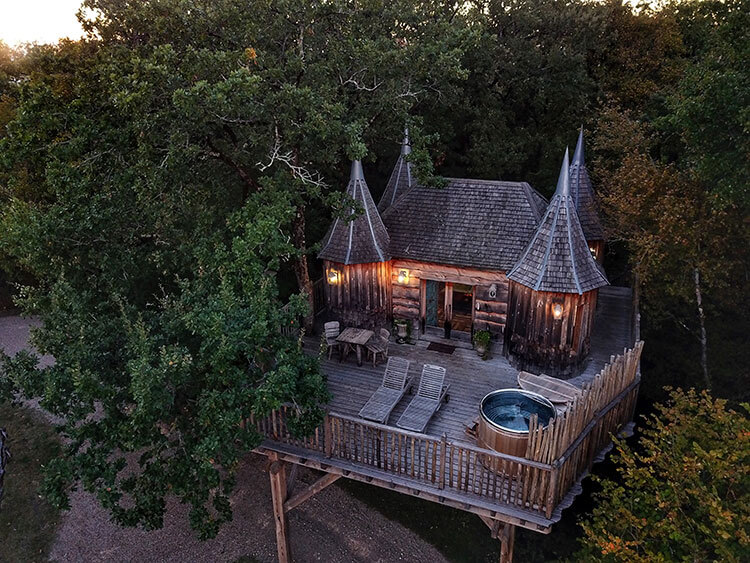The Dordogne River flows west through the South West of France, snaking through the soaring cliffs dotted by ancient châteaux and some of the most beautiful villages in France in the Périgord Noir. One of the best ways to experience this stunning part of France is by grabbing some paddles and canoeing the Dordogne.
A Dordogne canoe trip can last from just a few hours to several days while also camping along the Dordogne’s shores. A Dordogne canoe trip can even combine adventure and luxury with a stay in a château converted to a luxury hotel along the way. But no matter whether you canoe the Dordogne on a day trip or on a multi-day Dordogne holiday, this French adventure needs to be on your bucket list.

How to Spend a Day Canoeing the Dordogne from Vitrac to Beynac
For a day out on the Dordogne, the 16 kilometer route from Vitrac to Beynac is one of the most beautiful parts of the Dordogne River. The route encompasses five clifftop castles and three of the most beautiful villages in France on a calm part of the river perfect for any canoeing experience level.
It takes around 3 hours to canoe from Vitrac to Beynac, and there is a shuttle back to the launch point in Vitrac every hour with Canoës Loisirs. There are also points that you can you paddle ashore and visit some of the villages and their attractions along the way.

Vitrac
The route begins in Vitrac, considered to be the heart of the Périgord Noir. The beautiful village, a canton of Sarlat, has a population of just 872. But Vitrac once played an essential role in Bordeaux’s wine trade with England, first as a major producer of wine barrels and then as a builder of the Gabares (a special type of rive barge). The Gabares carried planks of wood for the barrels on the river to the Gironde.
There’s also a small island near Vitrac, which is a natural bird sanctuary. The Dordogne River is, after all, a UNESCO World Biosphere Reserve. You can not only admire the beautiful scenery of the honey-colored villages you’ll gently drift past, but also the possibility to spot birds like kites, buzzards and falcons.

La Roque-Gageac
The village of La Roque-Gageac is listed as one of Les Plus Beaux Villages de France, the most beautiful villages of France. The village sits on the Dordogne River and the honey-colored houses are built right in to the massive cliff that overhangs the village.
The village has been occupied since prehistoric times, making it one of the interesting villages to visit. On a walk through the village, follow the steps up to the troglodyte fort that dates back to the Viking invasions. On Friday morning from May – September there is also a food market and there are good restaurants in the village.
The Château de La Malartrie sits on the edge of the village. The castle dates back to the 12th century when it was originally a leper hospital. It sat abandoned for many years until it was purchased by the Count de Saint Aulaire. The Count transformed the castle in the Renaissance style it stands in today. It’s actually a lovely castle hotel you can stay in with a fabulous outdoor swimming pool.

Castelnaud-la-Chapelle
A little further down the river, you come to Castelnaud-la-Chapelle. This is another of the most beautiful villages of France, which sits on the confluence of the Dordogne and Céou rivers. The village is known for its two castles.
Château Castelnaud was built in the 12th century as a show of power to face its rival castle Château de Beynac. This castle too was once abandoned and nothing more than ruins by the time of the French Revolution. The medieval fortress is beautifully restored and today is a museum of medieval warfare. You can even try your hand at archery, a discipline that was well mastered by the soldiers during the Hundred Years War, or firing a trebuchet during various times throughout the year.
The second castle of Castelnaud-la-Chapelle is Château des Milandes. It was built in 1489 by François de Caumont, the Lord of Castelnaud, as a gift to his wife. Josephine Baker purchased it in 1947 after falling in love it while renting it. And today it is a beautiful manor hour with stunning gardens, a birds of prey show and an on-site restaurant.

Ecomusée de la Noix
Foodies won’t want to miss a visit the family-run Ecomusée de la Noix (The Walnut Ecomuseum) in Castelnaud, as the Périgord is the birthplace of the walnut. Walnuts are inextricably linked with the history of the Dordogne. The people here have been eating walnuts since the prehistoric times of the Cro-Magnon some 17,000 years ago.
Walnut oil, the main product produced from Périgord walnuts, was once so valuable that it was worth its weight in gold. Walnuts and walnut oil played a role in contributing to the wealth of the region. Walnuts were even used as a form of currency for peasants to pay off debts and walnut oil was accepted as a form of payment for taxes due to the local churches.
The Ecomusée de la Noix is a walnut plantation that has grown walnuts on the 7 hectares of land atop the hill of Castelnaud since the 18th century. At the museum/plantation, which has been open to the public since 1996, visitors can discover all the various food products walnuts are produced in to including walnut oil, walnut liquor, walnut beer, walnut butter and candied walnuts.

The mills in the old farmhouse turn all year round, giving visitors a look at hold the high-quality cold pressed virgin walnut oil is produced. First, dry walnuts are slowly crushed under the ever-turning grinding wheel into a kind of dough.

The dough is then heated for 30 minutes in a large cast iron bowl that is manually stirred constantly by one of the workers.

The warmed dough is then transferred to the press, where the force of 32 tons of pressure extracts the translucent honey-colored walnut oil from the dough. Visitors are offered a taste of the just-pressed walnut oil. You’ll never taste walnut oil so fresh anywhere else.
There’s also a small museum to walk through, which also has a short film of the walnut harvest. There are incredible sculptures carved from walnut wood, art featuring the walnut, and educational plaques about the different varieties of walnuts grown in the Périgord.

In the shop, visitors can buy the locally made products of the walnut plantation.

The Ecomusée de la Noix is also a Périgord truffle plantation, and visitors are also welcome to learn about the process of truffle hunting. Noxo, the truffle dog, is happy to show off her truffle finding skills in a demonstration in the oak groves where truffles grow on the roots of the trees.

Beynac-et-Cazenac
The third and final of the most beautiful villages of France to pass by on the 16 kilometer canoe trip from Vitrac is the village of Beynac-et-Cazenac. This beautiful village sitting on the north bank of the Dordogne River has been the setting for a number of movies, and Americans may have seen it in Chocolat with Juliette Binoche and The Messenger: The Joan of Arc Story with Dustin Hoffman.
There are quite a few shops and restaurants in pretty Beynac, but it is best known for Château de Beynac that crowns the top of the clifftop village. Château de Beynac is the best preserved of the Dordogne’s more than 100 castles.

The oldest part of clifftop castle was built in the 12th century by the barons of Beynac. The sheer cliff face was deterrent enough, so the oldest part of the castle is a Romanesque keep built on the plateau with a double moat, double crenellated walls and a double barbican. It was enlarged in the 16th and 17th centuries.
During the Hundred Years’ War, Château de Beynac was held by the French. The Dordogne River served as the border between France and England, and Château de Castelnaud on the opposite bank was held by the English. For a brief time it was captured by Richard the Lionheart.
The castle has been listed as a monument historique (a designation given to some French heritage sites) since 1944 and was purchased and restored in 1962. Today it is like a living museum transporting visitors back to the times of Richard the Lionheart and Elinor of Aquitaine. You can explore the dungeons, great halls with their sumptuous tapestries and get an incredible 360-degree view over the Dordogne valley from the towers.
Where to Stay in the Dordogne

Château de La Malartrie
Château de La Malartrie is a castle hotel overlooking one of the most beautiful villages of France, La Roque-Gageac. The castle has five rooms, each unique and named after various castle of the Dordogne. The Commarque room is a family room and our personal favorite is the decor of the Milandes room. There are also two apartments that have kitchens and are perfect for longer stays or families/groups.
Breakfast is included and is a spread of delicious foods from local producers of the Périgord. There’s also an outdoor heated swimming pool. And you can book massages for a relaxing moment or to soothe sore muscles from paddling on the river.

Château Dans Les Arbes
Located about an hour drive away from Vitrac is Château Dans Les Arbes, or the “castles of the trees”. These unique accommodations are luxury tree houses built to resemble several of the real castles of the Dordogne.
Each tree house at Château Dans Les Arbes is unique, but all of them either have a nordic-style hot tub or jacuzzi on their deck. Some even have more than one bedroom and are perfect for a family or friends traveling together. Breakfast of local products is delivered to the tree houses each morning in a picnic basket guests haul up using a pulley system.
Château Dans Les Arbes also has an outdoor swimming pool for guests, offers other activities like table tennis, petanque and games, and has a network of hiking trails. See what other travelers have to say at TripAdvisor.
Know Before You Go
Note that closed toe shoes are required and that children must be at least 5 years of age.
Shop This Post
Our trip to the Dordogne was in partnership with Dordogne Périgord Tourisme in order to bring you this story. However, Luxe Adventure Traveler maintains full editorial control of the content published on this site. As always, all thoughts, opinions, and enthusiasm for travel are entirely our own. This article contains affiliate links. When you shop onAmazonor book on Booking.com through our affiliate sites, we earn a small commission at no additional cost to you.

vanessa workman says
What an amazing tour, I would love to visit all of these places. 3 hours worth of canoeing sounds like a lot, but the scenery is so stunning along the Dordogne I imagine you barely noticed how long you were paddling. La Roque-Gageac sounds especially interesting. Looks quite young for her ancient age too!
Carol Colborn says
Canoeing Dordogne River for a few hours definitely gave you postcard perfect photos like the scene of Cénac-et-Saint-Julien from Vitrac and La Roque-Gageac & Castelnaud-la-Chapelles, two beautiful French villages.
Linda says
Canoeing the Dordogne sounds like such a great idea. Even better if you can plan a luxury stay at a chateau as well. A tree house at Château Dans Les Arbes sounds so fun. Good to know that the stretch between Vitrac and Beynac is the most scenic. And I was happy to hear there is a shuttle back after canoeing for 3 hours. I loved your photos of the sights along the way. A stop at the village of Beynac-et-Cazenac would definitely be something I would want to do.
Punita Malhotra says
Another lovely region of France…this country has endless such! We visited few of the Les Plus Beaux Villages and each was prettier than the other. Canoeing…yes, please!
Tom Bourlet says
Ah I’d love to canoe with that view! It’s incredible. I used to do a lot of kayaking on Brighton beach, but I’ve always heard it is much better on a river like this, where it softly pulls you along. Added to my list for 2020
Jean says
What an epic way to see areas of France. I love that you canoed along. Much more fun then being stuck in a tour bus and being shuffled around with a million others. Super convenient that they had a shuttle bus to pick you up though.
Renata says
Wow – the landscape as such is so breathtaking – and taking these views in from a canoe rowing at your own pace must be just wonderful.
Rosemary says
What a great way to explore the beautiful Dordogne region. Love the different options available, though the 3 hour trip sounds like fun. From your pictures, I’m guessing the waters were quite calm, which make it better 🙂 We recently started cooking with Walnut oil and I very much enjoyed reading about the experience at Ecomusée de la Noix. I’d love to sip on freshly ground walnut oil. Great article and I hope to visit the Dordogne soon…for the foie gras 🙂
Debra Schroeder says
Such a fun way to explore that part of France. I like the idea of combining canoeing with a luxury hotel stay especially in a place like the Château de la Malartrie. 🙂
Tami Wilcox says
I’m blown away by the beauty of these photos and what must be an incredible experience canoeing the Dordogne. This is something I would love to do. Now, I’ve just got to get myself back to southern France!